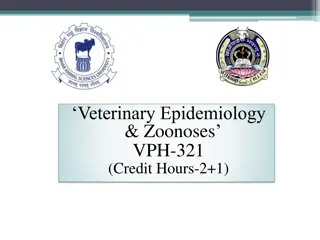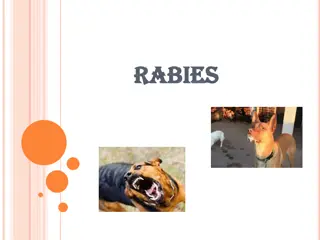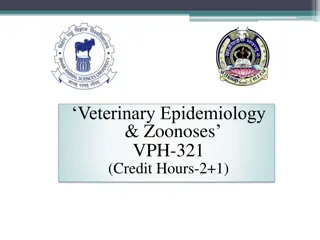Comprehensive Overview of Rabies: Causes, Symptoms, and Impact
Rabies, also known as hydrophobia, lyssa, or lytta, is a severe viral disease affecting mammals, including humans, leading to damage to the nervous system and inevitable death. The disease is caused by a large RNA neurotropic virus of the genus lyssavirus. Rabies is transmitted through the infected saliva of rabid animals, primarily through biting. The disease has a worldwide distribution, with major reservoirs in wildlife such as raccoons, skunks, bats, and more. Rabies has significant economic and zoonotic impacts, causing substantial losses in animals and humans. Clinical signs include both furious and dumb forms, with a short course of illness and high mortality rates.
Download Presentation

Please find below an Image/Link to download the presentation.
The content on the website is provided AS IS for your information and personal use only. It may not be sold, licensed, or shared on other websites without obtaining consent from the author. Download presentation by click this link. If you encounter any issues during the download, it is possible that the publisher has removed the file from their server.
E N D
Presentation Transcript
Rabies Hydrophobia, lyssa or lytta By Dr/ Marawan Elfky
Definition Severe worldwide, viral disease that can affect all mammals, including humans. Infection results in damage to the nervous system and always ends with death.
Etiology large RNA neurotropic virus of genus lyssavirus ,family rhabdoviradae, Susceptible to boiling and common disinfectants as ether, chloroform, formalin and sod hydroxide. Dies in dried saliva in few hours Persist in infected brain tissue for 7-10.d at room temperature and for several weeks at 4 c.
Epidemiology 1. Distribution: Worldwide and recorded in Egypt. 2. Host rang: (All mammals, including domestic and non-domestic animals and humans). Young more than adult. Less common guinea pigs, rabbits and pig Wildlife, raccoons, skunks, mongoose, bats are major reservoirs (immune carriers).
3. Seasonal incidence: Late summer and autumn because of large scale movement of wildlife at mating and pursuit of food . 4. Transmission: a. Source: infected saliva of rabid animal. b. Mode: Primary, biting of rabid animals. Occasionally, open wound or mucous membrane exposure to saliva of rabid animal.
5. Economic and zoonotic impact: Rabies considered a very dangerous disease with significant economic losses due to deaths in animals and human. The disease is zoonotic
Pathogenesis After biting of cattle by infected animal or wound contamination by the virus, spreading occur through the body via the bloodstream. Then the virus travels to the spinal cord and brain, at which point clinical signs of rabies often appear in cattle
Clinical signs I.P from 2 weeks to 6 months with short course (1-10 d.) Low morbidity rate and high mortality. There are 2 forms of the disease: A. Furious form B. Dumby form
A.Furious form Sudden behavior changes, and attack without stimulation with eating abnormal substances. Animals may be anxious, highly excitable and/or aggressive with intermittent periods of depression. Abnormal bellowing, which may continue intermittently until shortly before death. As the disease progresses, muscular weakness, incoordination, seizures and death.
B. Dumby form Cattle converted to be docile with depression. Paralysis, generally of the face, throat and neck, causing abnormal facial expressions, drooling of saliva and inability to swallow. Paralysis may affect the body, first affecting the hind legs then progresses rapidly to the whole body with subsequent coma and death.
P/M lesions There are no pathognomonic lesions except congestion and edema of meninges and brain. foreign materials in stomach of rabid cattle indicating depraved appetite
Diagnosis 1- Field diagnosis; depends on case history, clinical signs and P/M lesions. 2. Lab. Diagnosis; A. Sample: Head as a whole or brain, and smear or slices from brain and spinal cord. Salivary glands, saliva and nasal discharges. Serum
Diagnosis B. Laboratory procedures: Virus isolation on cell culture (CPE after 18-24.h) Microscopic examination of tissue smears after staining with seller s stain to detect intracytoplasmic inclusion bodies or Negri bodies (red or purpulish). Immunohistochemistry and IF to detect the virus in brain tissue. Serological tests as virus neutralization test
Negri bodies Rabies by IF
Differential Diagnosis The disease should be differentiated from all causes of nervous manifestation as in BSE:
Treatment No treatment should be attempted after appearance of signs. Post exposure prophylactic measures: o immediately after exposure or biting, irrigation of the wound by 20 % soaps and water may prevent virus attachment, suture of deep wounds with infiltration of the wound with anti-rabies immune sera.
Control & vaccination The main goal of animal s rabies control is to reduce or prevent infection of humans Depending on: Surveillance and reporting of suspected cases of rabies in animals Vaccination programs for domestic animals Wildlife rabies control programs.























